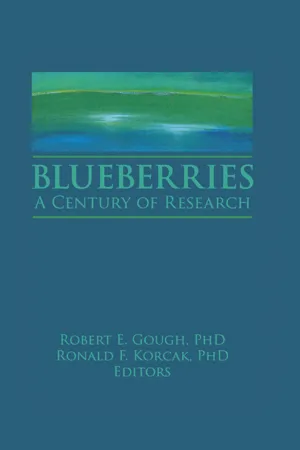
- 268 pages
- English
- ePUB (mobile friendly)
- Available on iOS & Android
About this book
Blueberries: A Century of Research presents the results of basic and applied research into blueberry science and culture around the world. It contains technical reports on genetics, nutrition, physiology, culture, and harvesting of several blueberry species. Readers will find much current, helpful, and interesting information for their work with blueberries.
General areas covered in the book are the blueberry culture and its future, blueberry genetics and diseases, blueberry nutrition, and blueberry fruit quality. Specific chapters address a variety of topics including:
- utilization of wild blueberry germplasm
- use of sparkleberry in breeding highbush cultivars
- identification of markers linked to genes controlling chilling requirement and cold hardiness
- detection of blueberry scorch virus and red ringspot virus
- methods of controlling blueberry gall midge damage
- control of bunchberry in wild blueberry fields
- blueberry nitrate reductase activity
- use of gibberellic acid as a management tool for increasing yield of rabbiteye blueberry
- blueberry culture and research in Japan
In Blueberries: A Century of Research, small fruit researchers, extension workers, and blueberry specialists will find important new information for continued improvement of blueberry culture and specialization. The book is a vital resource that appeals to a professional audience worldwide.
Frequently asked questions
- Essential is ideal for learners and professionals who enjoy exploring a wide range of subjects. Access the Essential Library with 800,000+ trusted titles and best-sellers across business, personal growth, and the humanities. Includes unlimited reading time and Standard Read Aloud voice.
- Complete: Perfect for advanced learners and researchers needing full, unrestricted access. Unlock 1.4M+ books across hundreds of subjects, including academic and specialized titles. The Complete Plan also includes advanced features like Premium Read Aloud and Research Assistant.
Please note we cannot support devices running on iOS 13 and Android 7 or earlier. Learn more about using the app.
Information
SECTION V:
Blueberry Nutrition
Organic Matter and Nitrogen Level Effects on Mycorrhizal Infection in ‘Bluecrop’ Highbush Blueberry Plants
INTRODUCTION
Table of contents
- Cover
- Half Title
- Title Page
- Copyright Page
- Table of Contents
- About the Editors
- Foreword
- Session I: Blueberries of the Future
- Session II: Blueberry Genetics
- Related Posters
- Session III: Blueberry Genetics Continued–Blueberry Diseases
- Related Posters
- Session IV: Blueberry Culture
- Related Posters
- Session V: Blueberry Nutrition
- Related Posters
- Session VI: Blueberry Fruit Quality
- List of Attendees